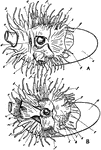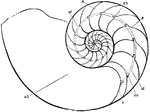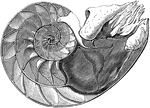Clipart tagged: ‘Nautilus pompilius’

Nautilus Oral Surface
"Oral surface of a male (A) and female (B) Nautilus pompilius in an expanded state. a, shell; b, external…

Chambered Nautilus
"Section of the shell of Nautilus pompilius, showing the septa (s, s), the septal necks (s. n., s. n.),…

Pearly Nautilus
The Pearly Nautilus (Nautilus Pompilius) is the only living representative of a unique form of cephalopod,…